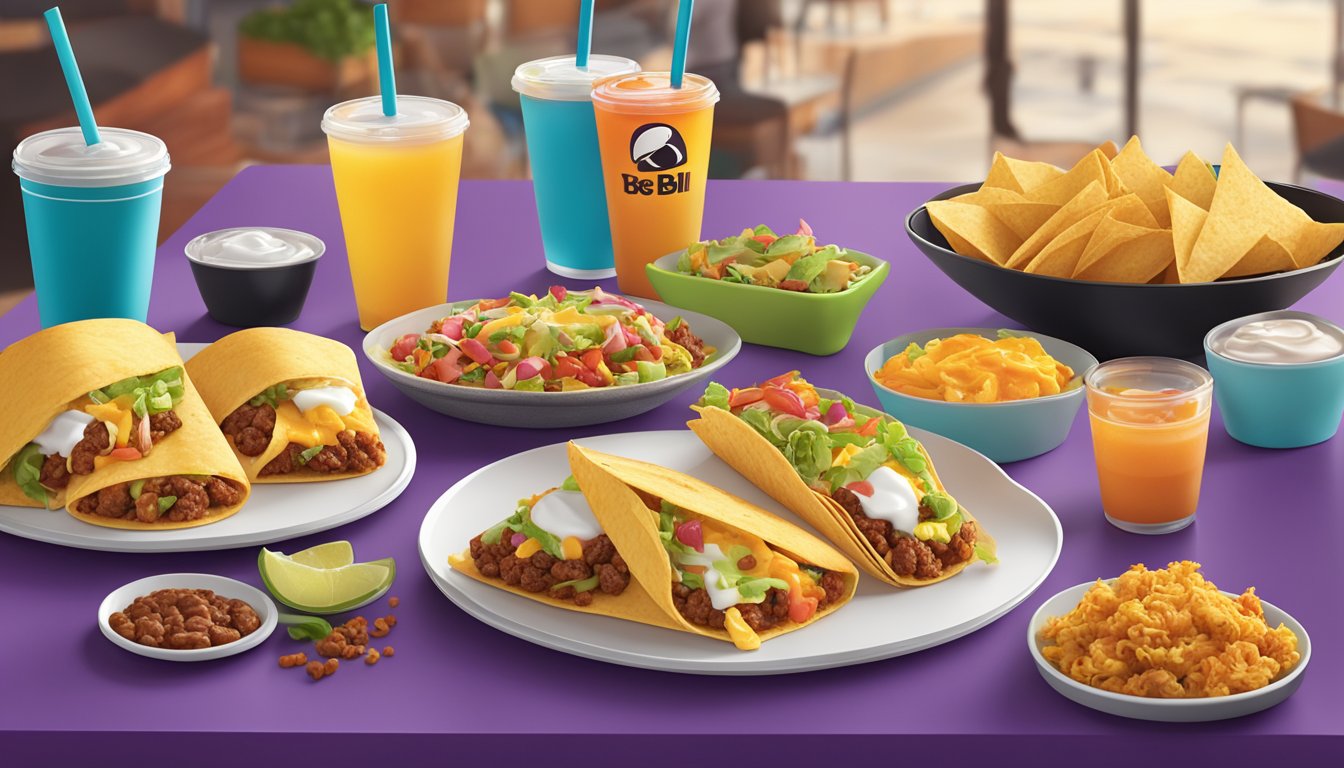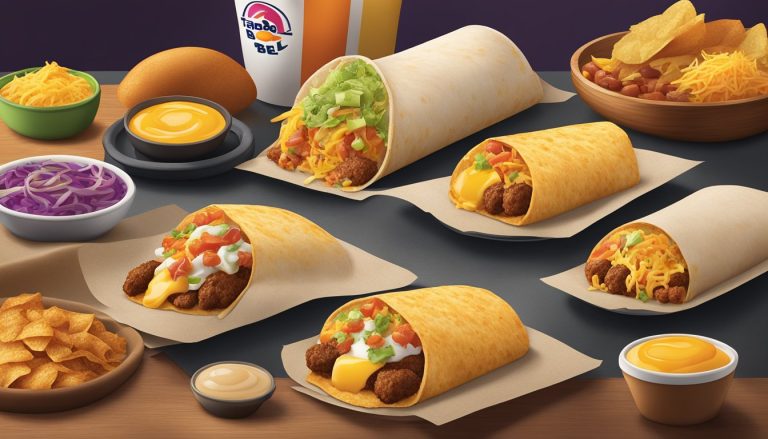Taco Bell made a bold move in 2014 by launching its breakfast menu nationwide. This strategic decision marked a significant expansion for the fast-food chain, venturing into a new meal occasion with substantial growth potential. The breakfast launch was supported by Taco Bell’s largest marketing campaign ever, demonstrating the company’s commitment to establishing itself as a serious contender in the morning food market.
The marketing strategy behind Taco Bell’s breakfast launch focused on differentiating itself from competitors. By offering unique menu items that aligned with its Mexican-inspired brand identity, Taco Bell aimed to stand out in a crowded breakfast landscape. This approach allowed the chain to leverage its existing brand recognition while appealing to consumers seeking alternatives to traditional breakfast fare.
Despite previous unsuccessful attempts at breakfast offerings, Taco Bell’s 2014 launch proved more enduring. Nearly five years later, the breakfast menu continued to thrive, indicating the effectiveness of the marketing strategy and the menu’s appeal to consumers. This success highlighted the importance of timing, market readiness, and a well-executed marketing plan in introducing a new product line.
Overview of Taco Bell’s Position in the Fast-Food Industry
Taco Bell stands as a prominent player in the fast-food industry, known for its Mexican-inspired cuisine. Founded in 1962, the chain has grown to become one of the largest fast-food restaurants globally.
With over 7,000 locations across 30 countries, Taco Bell has established a significant market share in the quick-service restaurant sector. The brand’s success can be attributed to its unique menu offerings and innovative marketing strategies.
Taco Bell’s position in the industry is strengthened by its ability to create buzz-worthy products. The introduction of the Doritos Locos Taco in 2012 exemplifies this approach, becoming one of the most successful product launches in fast-food history.
The chain faces competition from other Mexican-inspired fast-food outlets and traditional burger chains. Despite this, Taco Bell has maintained its distinct identity through creative menu items and engaging marketing campaigns.
Taco Bell’s target demographic primarily consists of young adults and late-night diners. The brand has successfully catered to this audience with its affordable prices and convenient locations.
Key factors contributing to Taco Bell’s market position:
- Unique menu offerings
- Innovative product launches
- Strong brand identity
- Competitive pricing
- Extensive restaurant network
Taco Bell continues to adapt to changing consumer preferences, exploring options like healthier menu items and plant-based alternatives to maintain its competitive edge in the fast-food industry.
Dissecting the Breakfast Market
The breakfast market presents unique challenges and opportunities for fast food chains. Consumer habits, menu offerings, and market positioning play crucial roles in capturing morning customers.
Breakfast Menu Evolution
Fast food breakfast menus have expanded beyond traditional items like eggs and bacon. Chains now offer diverse options including breakfast sandwiches, burritos, and healthier alternatives. Taco Bell’s breakfast menu introduced Mexican-inspired items like the Breakfast Crunchwrap and Cinnabon Delights. These unique offerings aimed to differentiate Taco Bell from competitors and appeal to younger consumers seeking novel breakfast experiences.
Chains regularly update their breakfast menus to keep pace with changing tastes. Popular additions in recent years include:
- Plant-based options
- All-day breakfast items
- Customizable breakfast bowls
Consumer Preferences and Morning Habits
Breakfast consumers value convenience, speed, and portability. Many prefer grab-and-go options that fit into busy morning routines. A 2024 survey found that 62% of breakfast customers prioritize quick service above all else.
Key factors influencing breakfast choices:
- Time constraints
- Nutritional value
- Taste preferences
- Price point
Younger demographics tend to skip traditional sit-down breakfasts in favor of on-the-go options. This shift has created new opportunities for fast food chains to capture morning sales.
Identifying the Breakfast Opportunity
The breakfast market represents a significant growth opportunity for fast food chains. Morning sales can boost overall revenue without cannibalizing lunch and dinner traffic. Taco Bell recognized this potential when launching its breakfast menu.
Factors driving the breakfast opportunity:
- Increasing number of people eating breakfast away from home
- Growing demand for all-day breakfast options
- Untapped market segments (e.g., night shift workers)
To succeed in the breakfast market, chains must offer unique value propositions. Taco Bell’s strategy involved leveraging its Mexican-inspired menu to stand out from traditional breakfast offerings.
Strategic Marketing Approaches
Taco Bell’s breakfast launch relied on key marketing strategies to differentiate itself and capture market share. The company focused on understanding consumer needs, leveraging its brand identity, and creating compelling value propositions.
Market Research and Target Audience
Taco Bell conducted extensive market research to identify its target audience for breakfast. The company focused on millennials and young adults who sought affordable, convenient, and unique breakfast options. Surveys and focus groups helped Taco Bell understand consumer preferences and habits.
The research revealed that many young consumers skipped breakfast due to time constraints or lack of appealing options. Taco Bell used this insight to tailor its breakfast menu and marketing messages.
To reach its target audience effectively, Taco Bell utilized social media platforms and digital advertising. The company also employed influencer marketing to generate buzz and appeal to younger demographics.
Brand Positioning and Identity
Taco Bell positioned its breakfast offerings as bold, innovative, and distinctly “Taco Bell.” The company leveraged its existing brand identity to create a unique breakfast experience that stood out from traditional fast-food breakfast options.
Key elements of Taco Bell’s breakfast brand positioning included:
- Playful and irreverent marketing campaigns
- Menu items that combined breakfast staples with Mexican-inspired flavors
- Bold flavor profiles that appealed to younger taste preferences
The company’s “Wake Up Live Más” slogan reinforced its brand identity and differentiated its breakfast offerings from competitors.
Creating Unique Value Propositions
Taco Bell developed several unique value propositions to attract breakfast customers:
Novel menu items: Waffle Tacos, A.M. Crunchwraps, and Breakfast Burritos offered innovative alternatives to standard breakfast fare.
Affordable pricing: Competitive prices appealed to budget-conscious consumers.
Extended breakfast hours: Serving breakfast until 11 a.m. catered to late risers and shift workers.
Customization options: Customers could personalize their breakfast items, enhancing the value proposition.
By emphasizing these unique aspects, Taco Bell aimed to carve out a distinct niche in the competitive breakfast market and drive customer loyalty.
Taco Bell’s Breakfast Product Offerings
Taco Bell’s breakfast menu features a blend of traditional morning favorites with a Mexican-inspired twist. The offerings include portable handheld items and innovative creations that cater to on-the-go consumers seeking unique breakfast options.
Core Breakfast Items
Taco Bell’s breakfast lineup centers around several key items. The Breakfast Crunchwrap stands out as a signature offering, combining scrambled eggs, bacon or sausage, cheese, and hash browns in a grilled tortilla. Breakfast burritos are another staple, filled with various combinations of eggs, cheese, and meats.
The menu also includes quesadillas with breakfast ingredients. For those with a sweet tooth, Cinnabon Delights provide bite-sized pastries filled with cream cheese frosting. Coffee and other beverages round out the core offerings.
Innovative Menu Additions
Taco Bell’s breakfast innovation shines through unique items like the Waffle Taco. This creation featured a folded waffle shell filled with scrambled eggs, cheese, and meat. While no longer on the menu, it showcased the brand’s willingness to experiment.
Other creative additions have included breakfast-themed nachos and variations on classic menu items. Taco Bell continues to introduce limited-time offerings to keep the breakfast menu fresh and exciting.
The chain’s approach to product innovation focuses on combining familiar breakfast ingredients with their signature Mexican-inspired flavors and formats. This strategy aims to differentiate Taco Bell’s breakfast from traditional fast-food morning menus.
Promotional Tactics and Campaign Execution
Taco Bell’s breakfast launch relied on innovative digital strategies and strategic partnerships to generate buzz. The campaign leveraged multiple channels to reach target audiences and drive awareness of the new menu offerings.
Leveraging Digital and Social Media
Taco Bell executed a comprehensive digital marketing strategy for its breakfast launch. The company created eye-catching social media content across platforms like Instagram, Twitter, and TikTok. Short video ads showcased the new breakfast items in creative ways.
The brand also ran targeted display ads and sponsored content on popular websites and mobile apps. An interactive microsite allowed users to explore the breakfast menu and find nearby locations. Taco Bell utilized email marketing to reach existing customers with promotional offers.
Geotargeted mobile ads were deployed to reach potential customers during prime breakfast hours. The campaign included a hashtag challenge on TikTok that encouraged user-generated content.
Influencer Partnerships and Endorsements
Taco Bell collaborated with a diverse group of influencers to promote its breakfast offerings. The brand partnered with food bloggers and lifestyle influencers to create sponsored content. These posts featured appetizing photos and reviews of the new menu items.
Celebrity endorsements played a key role in the campaign. Notable personalities appeared in TV commercials and social media ads. Athletes and musicians with large followings shared their Taco Bell breakfast experiences online.
Micro-influencers in local markets helped drive awareness at a grassroots level. The brand hosted influencer events at select locations, generating additional social media coverage. Taco Bell also engaged with popular morning radio shows for on-air promotions and giveaways.
Consumer Engagement and Brand Loyalty

Taco Bell’s breakfast launch success hinged on fostering strong connections with its target audience. The brand implemented innovative strategies to cultivate loyalty and encourage active participation from consumers.
Community and Customer Feedback
Taco Bell leveraged social media platforms to create a vibrant community around its breakfast offerings. The company encouraged customers to share their experiences and menu preferences online.
User-generated content campaigns invited fans to showcase their Taco Bell breakfast moments. This approach resonated particularly well with young adults and college students.
The brand actively solicited customer feedback through surveys and focus groups. This valuable input helped refine menu items and improve overall customer satisfaction.
Taco Bell’s responsive approach to criticism and suggestions demonstrated its commitment to meeting consumer needs. The company frequently implemented changes based on customer input, further strengthening brand loyalty.
Building Emotional and Personal Connections
Taco Bell crafted marketing messages that appealed to the emotions and lifestyles of its target audience. Advertisements often featured relatable scenarios for teenagers and young adults.
The brand’s quirky and humorous tone in marketing communications helped forge a personal connection with consumers. This approach made Taco Bell feel more like a friend than a faceless corporation.
Personalization played a key role in Taco Bell’s engagement strategy. The company used data analytics to tailor promotions and offers to individual preferences.
Loyalty programs rewarded frequent customers with exclusive perks and early access to new breakfast items. These initiatives incentivized repeat visits and fostered a sense of belonging among patrons.
Harnessing Technology
Taco Bell leveraged digital platforms to support its breakfast launch. The company integrated mobile technology and social media to engage customers and drive awareness of the new menu offerings.
The Role of the Taco Bell Mobile App
The Taco Bell mobile app played a crucial role in promoting the breakfast menu. It offered exclusive deals and discounts for breakfast items, encouraging customers to try the new offerings.
Users could easily browse the breakfast menu, customize orders, and place them for pickup or delivery through the app. This convenience aligned with the fast-paced morning routines of many consumers.
The app also featured a loyalty program, rewarding frequent breakfast purchases with points redeemable for free items. This incentivized repeat visits and helped build a loyal breakfast customer base.
Push notifications reminded users about breakfast hours and special promotions, keeping the new menu top-of-mind. The app’s location-based services directed customers to nearby Taco Bell restaurants serving breakfast.
Taco Bell used app data to analyze customer preferences and refine its breakfast offerings. This insights-driven approach allowed for menu optimization based on real-time feedback and ordering patterns.
Challenges and Opportunities
Taco Bell’s breakfast launch presented a mix of hurdles and potential rewards. The company faced operational complexities while aiming to capitalize on untapped market segments.
Navigating Operational Complexities
Introducing breakfast hours required significant adjustments to Taco Bell’s operations. Stores needed to open earlier, necessitating changes in staff schedules and training programs. The breakfast line demanded new equipment and ingredients, increasing inventory management challenges.
Maintaining food quality and consistency across all locations during the early morning rush posed another obstacle. Taco Bell had to ensure its breakfast items met customer expectations while adhering to quick service times.
Capitalizing on Market Segments
Taco Bell’s breakfast strategy targeted specific demographic and behavioral segments. Young adults and millennials, known for unconventional eating habits, were prime targets for the unique breakfast offerings.
Market segmentation allowed Taco Bell to tailor its breakfast menu to appeal to various groups. This included health-conscious consumers seeking protein-rich options and value-oriented customers looking for affordable morning meals.
Behavioral segmentation focused on capturing both habitual breakfast eaters and those who typically skip the meal. Taco Bell aimed to convert occasional customers into regular breakfast patrons, driving business growth in a previously untapped daypart.
Strategic Analysis and Future Directions
Taco Bell’s breakfast launch presents significant opportunities for revenue growth and strategic partnerships. The company’s bold move into the morning meal segment positions it to capture market share and expand its customer base.
Assessing Revenue Growth
Taco Bell’s breakfast menu has the potential to drive substantial revenue increases. By tapping into the $50 billion fast-food breakfast market, the chain could see a 15-20% boost in overall sales. Morning offerings may attract new customers and encourage existing patrons to visit more frequently.
The company’s unique Mexican-inspired breakfast items differentiate it from competitors, potentially leading to higher profit margins. Taco Bell’s ability to leverage its existing kitchen equipment and staff for breakfast service minimizes additional operational costs, further enhancing profitability.
Potential Strategic Partnerships
Collaborations with complementary brands could amplify Taco Bell’s breakfast success. Partnering with a popular coffee chain could address the lack of premium coffee options, a crucial element for many breakfast consumers.
Co-branding opportunities with cereal or yogurt manufacturers might lead to innovative menu items, attracting health-conscious customers. Teaming up with delivery services could expand Taco Bell’s reach to office workers and busy professionals seeking convenient breakfast options.
These partnerships could provide Taco Bell with valuable expertise in breakfast-specific areas, enhancing its competitive edge in the morning meal market.




